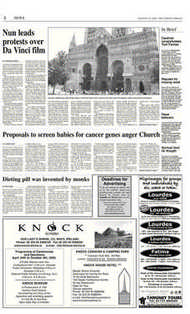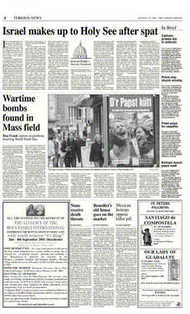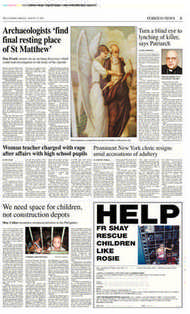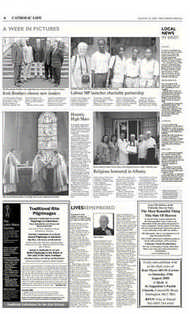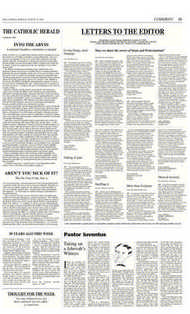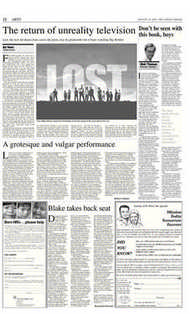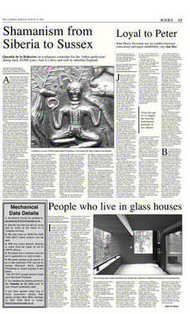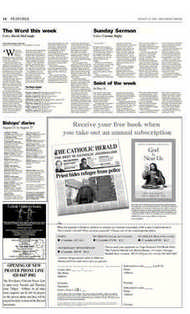Page 12, 19th August 2005
Page 12

Report an error
Noticed an error on this page?If you've noticed an error in this article please click here to report it.
Tags
Share
Related articles
The Monstrous Myths Of Blake's Book Of Job
Too Many Pictures, Too Little Light
Music In The Cathedral The Tradition Of Great Choral Works
Blake's 'private Language'
The Latest Books
Blake takes back seat
During the 10 years William Blake lived in Lambeth, 1790 to 1800, he wrote the Songs of Experience, The Marriage of Heaven and Hell and several other works defining his place in literary history.
The Museum of Garden History, housed in the former Church of St Mary’sat-Lambeth, asked a dozen contemporary artists and writers to give their reflections on this.
Be warned: blink and you’ll miss it. The substance of this “exhibition” is in the neatly produced catalogue, offering these artists’ versions of Blake’s idiosyncratic vision. Alas, apart from Michael Phillips’s topographical essay, it is a dire collection of art school pretentiousness.
The artworks on display are frankly disappointing: an autocued text of the sonnet “Jerusalem” (pompously described as “sculpture”, it looked like a standard autocue to me); a facile assemblage of vomiting artificial flowers (“sick rose”) hidden in the well of a much more interesting feature (an immersion font installed as a memorial to the fearsome Edward White Benson, Archbishop of Canterbury), a collage of printed pastiche flyers for a Blake weblog; and so on.
The most impressive object is an inscribed black sphere by Andy Harper, suspended above the baptistery and oddly titled An
Orrery for Other Worlds (pedantically, I always supposed an orrery was a mechanical scale model of celestial objects moving relative one to another).
Overall, the exhibits were to my eye qualitatively indistinguishable from an average sixth-form art project. They are, moreover, confusingly hidden away from the main collections.
On the face of it, then, this should have been a disappointing experience; but fortunately there is more here than this ephemera. The museum is a gently restful and benign place, with numerous monumental curiosities hidden or unadvertised.
The church itself is an unremarkable Victorian restoration of a 14th-century decorated original, adorned with that bland stained-glass portraiture once beloved of Anglican congregations.
Behind it is a recreated 17th-century Knot Garden, a geometrical and numerological excursus from the tradition that gave us, notably, Sir Thomas Browne’s intricate meditation The Garden of Cyrus.
To my pernickety eye, it looked a touch overgrown. Here the seventeenth century plant hunters and general collectors, the Tradescants, whose work inspires the entire museum, have a nobly adorned Victorian sandstone tomb.
Their incongruous neighbour in death, in a sparely pompous neoclassical box of Coade Stone, is the remarkable William Bligh, now remembered only as the cartoon villain of endless cinematic Mutinies on the Bounty, but famous in his own day as one of Nelson’s captains, pioneer of breadfruit cultivation, and for the staggering feat of seamanship when after the mutiny he brought his companions safe home after 4,000 miles in an open boat.
The body of the church currently houses an exhibition about the gardens of Hatfield House (Tradescant was Lord Salisbury’s gardener; the current Marquess is prominent in the Museum’s list of patrons). This sits well with the standing collections of gardening tools and herbological paraphernalia. Buried in the chancel (mostly hidden behind display boards) are fully six Archbishops of Canterbury.
In a side chapel is Elias Ashmole, alchemist, antiquary and freemason, whose eponymous museum in Oxford was founded largely with materials acquired from the Tradescants. These associations are rare pleasures.
As a neglected treasure in this part of London, the Museum is well worth visiting; just don’t expect to learn much about William Blake.
Cloud and Vision: William Blake at Lambeth is at the Museum of Garden History, St Mary’s-at-Lambeth, until September 4.
Raymond Edwards
blog comments powered by Disqus



